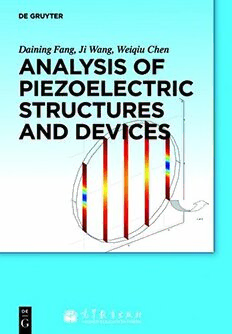
Analysis of Piezoelectric Structures and Devices PDF
Preview Analysis of Piezoelectric Structures and Devices
Analysis of Piezoelectric Structures and Devices Analysis of Piezoelectric Structures and Devices Edited by Daining Fang Ji Wang Weiqiu Chen De Gruyter PhysicsandAstronomyClassificationScheme2010:77.65.-j,85.50.-n,77.84.-s,77.65.Dq,77.84.Lf ISBN 978-3-11-029788-1 e-ISBN 978-3-11-029799-7 LibraryofCongressCataloging-in-PublicationData ACIPcatalogrecordforthisbookhasbeenappliedforattheLibraryofCongress. BibliographicinformationpublishedbytheDeutscheNationalbibliothek TheDeutscheNationalbibliothekliststhispublicationintheDeutscheNationalbibliografie; detailedbibliographicdataareavailableintheInternetathttp://dnb.dnb.de. ”2013HigherEducationPressandWalterdeGruyterGmbH,Berlin/Boston Printingandbinding:Hubert&Co.GmbH&Co.KG,Göttingen (cid:2)(cid:2)Printedonacid-freepaper PrintedinGermany www.degruyter.com Preface Typicalpiezoelectricstructuresofdevicessuchasresonators,actuators,andtransducers havebeenknownastargetsforanalysiswiththeconsiderationofcoupledfieldsincluding mechanical,electrical,andthermal,tonameafew,inapplicationsconcerningelectronic functionsforfrequencycontrolanddetectionandsensorsfordatacollection.Indeed,uti- lizationofpiezoelectricstructureswithprimaryobjectiveofaccuratevibrationfrequency hasbeenfoundinawidearrangeofpracticalproblemsandin-depthstudiesarerequired particularlyinthestronglydemandedbiologicalandchemicalsensortechnologyassens- ingelements.Tomeetapplicationneeds,researchworkfocusingonissuesintheanalysis ofpiezoelectricelementsindevicesandstructuresforsensorandcontrolapplicationshas beenconductedforrefinedpredictionsofcharacteristicsandbehaviortowardsoptimalde- signandimprovement.Suchmethodsandsolutionsarewidelypresentedinconferences andpublicationsofappliedmechanics,whichisnotwellcommunicatedwithapplication engineersofelectronicdevicesformanyreasons. Thecorerequirementsfortheanalysisofpiezoelectricstructuresaredeformation,vi- brationfrequency,modeshapes,electricpotential,andelectricchargedistribution,among others. These results can be used for the precise design of device structures for sensor andactuatorapplicationswithpropertiesintermsofbothmechanicalandelectricalvari- ables. It is clear that the precise analysis is the key to good design which can be better achievedwithanalyticaltechniquesratherthanempiricalapproachesthroughthecombi- nationofexperimentsandexperiencesofgoodandacceptabledesigns.Tothisgoal,many works have been done with analytical solutions based on approximate theories with the considerationofconfiguration,materials,andcomplications.Suchtheorieshavealsobeen expandedtoconsiderthecoupledfieldsrequiredintheanalysisofdeviceswithprimary considerationsofthermalandelectricalvariables,whicharealsoneededintheformula- tionandestimationofelectricalparameters.Indeed,sucheffortshavebeensuccessfulin certain applications with sophisticated methods and techniques for the analysis and de- signofdevicesandstructuresmeetingtheprecisionneedsofproductdevelopmentsuchas quartz crystal resonators based on the Mindlin plate equations and follow-up expansion for the thermal considerations. In addition, the Mindlin plate equations have been ex- tendedtothefiniteelementanalysisforaccurateandpracticalanalysis.Theadvantageof approximatetheoryhasbeenwelldemonstratedwiththeaccuracyandsimplicityofsuch analysiswithbothanalyticaltechniquesandnumericalmethods,showingbenefitsofap- proximate methods as one of the needed proofs for further research on the methods. It vi Preface is certainly well accepted in device and structure analysis because similar efforts have beenmadeinrelatedmannersandtheresultsinacceleratedanalysishavebeenembraced throughimprovements. Tosummarizerecentprogressontheanalysisofpiezoelectricstructuresinengineer- ingapplications,wehaveinvitedafewactiveresearchersonthissubjectmattertoprovide state-of-art accounts on a few topics with broad interests. From these contributions, we canfindoriginalresearchworkcloselyrelatedtostructuralanalysis,devicedesign,funda- mentaltheory,complicationfactors,andperformanceevaluationthroughboththeoretical and experimental approaches. Such theory and methods are important in many appli- cations such as actuators, energy harvesters, sensors, resonators with the consideration ofnovelmaterials(photostrictive,multiferroic,functionallygraded,layered)andvarious configurations(plates,shells,composites).Thewavemodesinvolvedintheanalysiscover thecommonlyutilizedsurfaceacousticwaves(SAW),bulkacousticwaves(BAW)asthe key functioning modes for extensive studies. In addition, there are novel approaches to establishnewmethodsandtechniquesfortheanalysisoftraditionaldevicestructuresfor possible fast and accurate predictions of essential vibration properties such as the fre- quency,modeshapes,chargedistribution,andeffectsofcomplicationfactorssuchassur- face,thermal,acceleration,stress,electricfieldanddrive-level,andsoon.Theseresults can be used not only for the validation and optimization of designs, but also in the cal- culationofelectricalparametersofdeviceswhicharecommonlyfunctioningaselectrical elementsinmodernelectroniccircuits.Theimportanceofsuchanalyticaltechniquesand methods is increasingly apparent not only in the computer-based product development process with advantages over time and cost but also international collaboration in the manufacturingandproductconceivingprocess.Clearly,majoreffortspioneeredthrough such research should be appreciated and further advances with emphasis on the experi- mental validation of analytical models and results to improve the product development cyclewithoutanygapleftshouldalsobeencouraged. The overall research on the acoustic wave devices and structures involving materi- als, physical acoustics, and electrical parameters has been active in core groups meet- ing the growing need of new types of electronic and intelligent products, and many of the contributors of this volume have been playing leading roles in research and teach- ing. More importantly, these active researchers are also heading different directions in diversified communities and groups spanning geologically in the electronic, materials, physical acoustic, and mechanics fields. Such activities will bring the urgent technical challenges to be known by more engineers and scientists with the expected outcome of enrichedknowledgeandincreasedinvolvementinresearchandstudying.Undoubtedly, this will make the subject matters more appealing to generations of students and prac- tical engineers as we have been hoping. This book present the frontiers of piezoelectric structures and devices research in a unified and grouped collection, and will certainly helpstudents,engineers,professors,andtechnologiststofindtheinformationandmeth- ods needed to guide their participation and anticipation in the field and industry. This is the latest addition to our dedication of a broader professional and technical exchange Preface vii throughconferencessuchastheIEEEFrequencyControlandUltrasonicsSymposia,the SPAWDA,andotherworkshopsandmeetingswehavebeenorganizinginlastdecades. Editors DainingFang JiWang WeiqiuChen PekingUniversity NingboUniversity ZhejiangUniversity August,2012 Contents Chapter1 JingJiang,HongHaoYue,ZongQuanDeng,andHornSenTzou Non-uniformActuationsofPlatesandShellswithPiezoelectric andPhotostrictiveSkew-quadActuatorDesigns 1 1.1 Introduction 2 1.2 NewSQactuatorsystem 3 1.2.1 Thedistributionprofileofinducednon-uniformforces andmoments 4 1.2.2 DesignofanSQactuatorsystem 7 1.3 PlatecontrolwithapiezoelectricSQactuatorsystem 7 1.3.1 Non-uniformforcesandmomentsinducedbytheSQactuator system 8 1.3.2 Modalcontrol 9 1.3.3 Casestudies:controlofplates 10 1.3.4 Closed-loopactuationwithcollocatedsensorsandactuators 16 1.3.5 Summaryofnon-uniformpiezoelectricactuationsofplates 20 1.4 CylindricalshellcontrolwithphotostrictiveSQactuatorsystems 21 1.4.1 Uniformandnon-uniformphotostrictiveactuation 22 1.4.2 PhotostrictiveSQactuator 24 1.4.3 Modalcontrol 26 1.4.4 Casestudies:photostrictiveactuationofshells 27 1.4.5 Closed-loopactuationwithpairedSQactuatorsystems 34 1.4.6 Summaryofnon-uniformphotostrictiveactuationsofshells 36 1.5 Summary 37 References 39 Appendix 41 Chapter2 ChunLiZhangandWeiQiuChen StructuralTheoriesofMultiferroicPlatesandShells 43 2.1 Introduction 44 2.2 Basicformulations 45 2.3 Laminatedmultiferroicshellequationsinorthogonalcurvilinear coordinates 46
